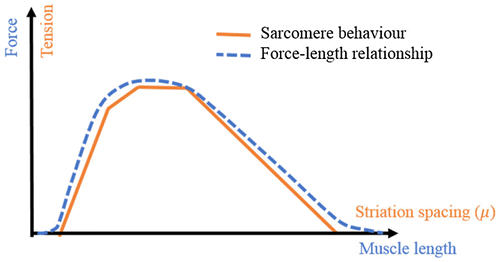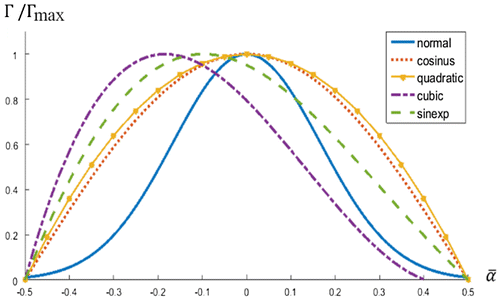 ?Mathematical formulae have been encoded as MathML and are displayed in this HTML version using MathJax in order to improve their display. Uncheck the box to turn MathJax off. This feature requires Javascript. Click on a formula to zoom.
?Mathematical formulae have been encoded as MathML and are displayed in this HTML version using MathJax in order to improve their display. Uncheck the box to turn MathJax off. This feature requires Javascript. Click on a formula to zoom.1. Introduction
In biomechanics, modelling musculoskeletal behaviour opens large perspectives for injury prevention enabling non-invasive internal forces prediction. Current muscle models rely on isometric force-length and force-velocity relationships. The first can be extrapolated from sarcomere behaviour to a group of muscle actuating joint as a torque-angle relationship. At sarcomere level, the force-length curve can be divided in distinct linear physiological zones. At higher levels, the inter-fibres or inter-muscles variations attenuate the delimitations between zones, creating a continuous curve (Rassier et al. Citation1999) as shown in Figure . In addition, the angle-moment arm relationship comes into account when considering joint torque.
Whatever the model, the persistent physiological parameters used to shape the isometric curve at any level are maximal muscle force or joint torque and optimal muscle length or joint angle at which maximal force or torque is reached. On both sides of optimal length or angle, maximal force decreases as the muscle is stretched or shorten. Various mathematical functions were proposed to reproduce the described behaviour, at muscle or joint level, however no comparison was presented to legitimate that choice. Especially, normal curve (Zajac Citation1989), quadratic spline (Chow & Darling Citation1999), cubic spline (Lloyd & Besier Citation2003), cosinus wave (Anderson et al. Citation2007), or a sinus exponential wave (Hatze Citation1977) are often used. The purpose of our study was to evaluate the effect of the mathematical model on the fitting of actual maximal isometric torques measured on a dynamometer and its ability to be expanded to a 3D torque-angle-velocity model as in (Anderson et al. Citation2007). Our hypothesis is that an asymmetrical model (cubic or sinus exponential) can better fit the joint maximal torque-angle relationship than all other models.
2. Methods
2.1. Isokinetic measurement
15 participants (33 ± 7 yrs; 1.67 ± 0.05 m; 70 ± 22 kg) performed maximal isometric and isokinetic elbow flexion and extension on a dynamometer. The participants were seated in upright position with the arm alongside and flexed at 90° while the axis of the dynamometer was aligned on its elbow.
In total, 22 trials were recorded: 5 isometric trials at angles evenly varied through the participant’s specific range of motion and 6 concentric or eccentric trials at different 60°.s−1, 120°.s−1, or 150°.s−1 in both directions. A reference anatomical angle was also measured using goniometer.
2.2. Torque-angle mathematical models
Five mathematical models predicting maximal toque to angle relationship were tested. All depended on maximal isometric torque (Γmax), and joint angle to optimal joint angle distance normalized by maximal range of isometric force production () normalized as represented in Figure .
Normal: ,
Cosinus: ,
Quadratic: ,
Cubic: ,
Sinexp: .
2.3. Musculoskeletal optimisation
A three-steps Levenberg-Macquart optimisation was realised on isometric, concentric and eccentric data successively as in (Anderson et al. Citation2007). Optimal joint force-length and force-velocity parameters that minimize the quadratic distance between predicted torque and measurements were computed. Maximal torque Γmax, optimal angle α0, and range of motion RoM were obtained from isometric optimisation. Then, angular velocities at 50% and 75% of maximal torque were obtained from concentric optimisation. Finally, the concentric/eccentric ratio was obtained from eccentric optimisation.
Models were then evaluated through the overall residuals of each step of the optimisation.
3. Results and discussion
Average residual errors between measured and modelled normalized torque from the isometric, concentric and eccentric optimization steps are summarized in Table .
Table 1 Average normalized torque residuals for the isometric (ISO), concentric (CON) and eccentric (ECC) optimisation steps with each model
Looking at isometric torque only, the differences between the models is pretty small, except with the normal and sinexp models in extension. However, when expanding to concentric and eccentric torques in both directions, the residuals propagate largely and the cubic model generally fitted the best the data. Surprisingly, the sinexp model, asymmetrical too, best fitted flexion, but did not seem good at fitting elbow extension torques.
In general, residuals reported for isokinetic torque were much larger than the isometric one. Therefore, an adjustment of torque-velocity mathematical model remains the priority and will later be investigated as well.
In addition, the quadratic model is the further from actual data for the eccentric part of the torque. Average errors obtained with cosinus seem larger than those obtain in Anderson’s study on lower limb joints. A joint-specific investigation could be interesting to be able to generalize our results to rest of the body. This suggests that even a joint or motion specific model might be chosen. Further results with a larger number of subjects and statistical analysis should answer that question.
4. Conclusions
The choice of the mathematical model can contribute to the reproduction of realistic musculoskeletal behaviour. Asymmetrical models are suggested to model maximal elbow torque. Specifically, sinus exponential or cubic functions seem most appropriate for elbow flexion and extension respectively. Present results also suggest that a similar investigation on the torque-velocity curve might help improve Anderson’s model.
References
- Anderson D. E. et al. (2007). Maximum voluntary joint torque as a function of joint angle and angular velocity: model development and application to the lower limb. Journal of biomechanics, 40(14), 3105–3113.
- Chow J.W., & Darling W. G.. (1999). The maximum shortening velocity of muscle should be scaled with activation. Journal of Applied Physiology, 86(3), 1025–1031.
- Hatze H.. (1977). A myocybernetic control model of skeletal muscle. Biological cybernetics. 25(2):103–119.
- Lloyd D. G, & Besier T. F. (2003). An EMG-driven musculoskeletal model to estimate muscle forces and knee joint moments in vivo. Journal of biomechanics, 36(6), 765–776.
- Rassier D. E., MacIntosh B. R., & Herzog W. (1999). Length dependence of active force production in skeletal muscle. Journal of Applied Physiology, 86(5), 1445–1457.
- Zajac F. E. (1989). Muscle and tendon Properties models scaling and application to biomechanics and motor. Critical reviews in biomedical engineering, 17(4), 359–411.


